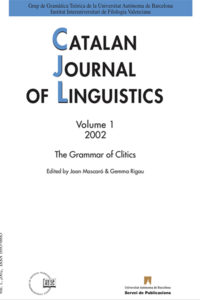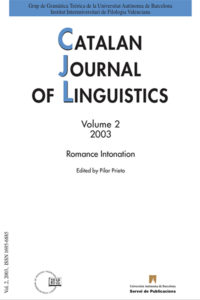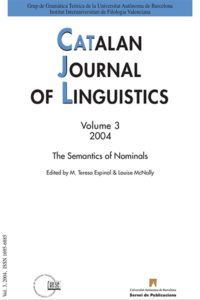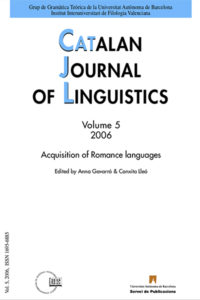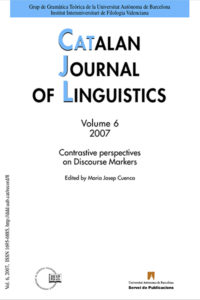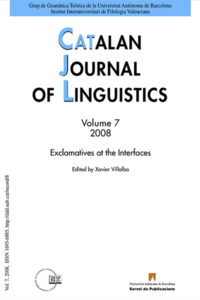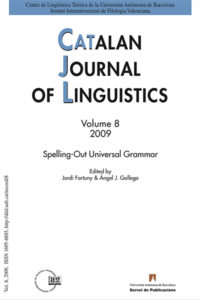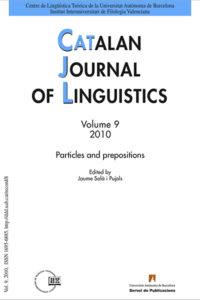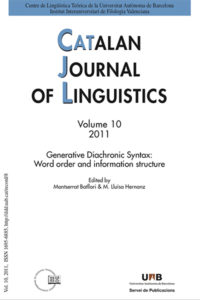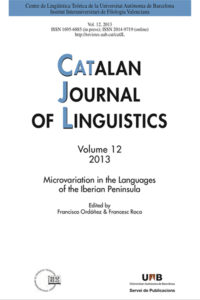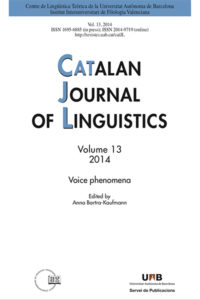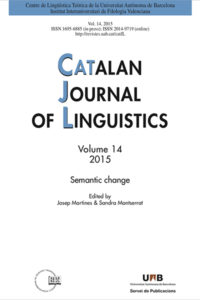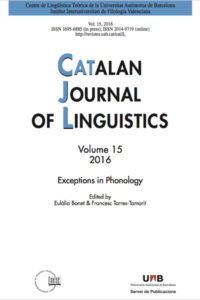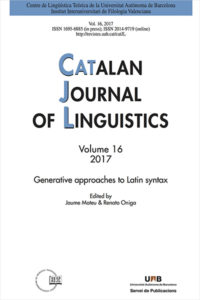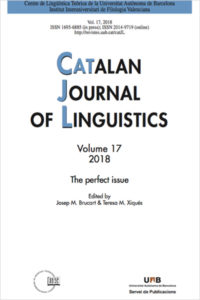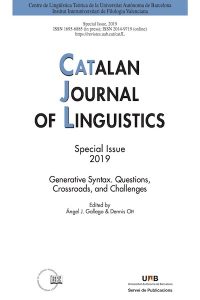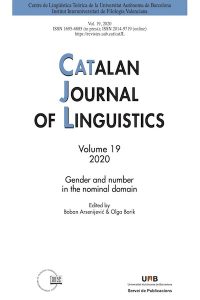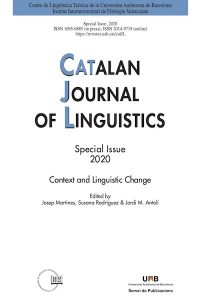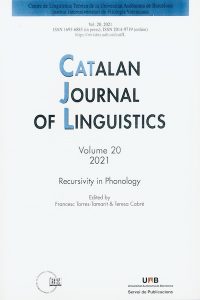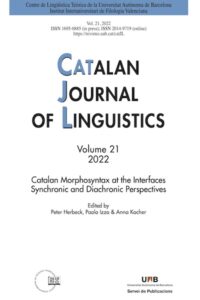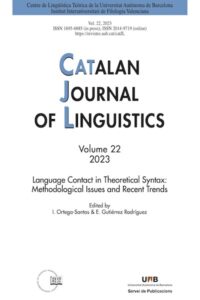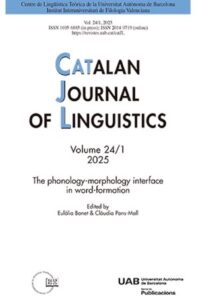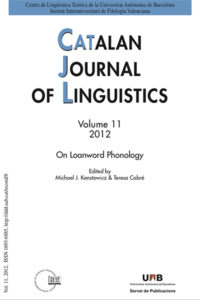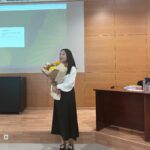25 maig, 2012

Autors:
Michael J. Kenstowicz & Teresa Cabré (ed.)
Títol:
On loanword phonologyEditorial: Universitat Autònoma de Barcelona, Servei de Publicacions
Col·lecció: Catalan Journal of Linguistics #11Data de publicació: 2012
Pàgines: 191 Text completThe study of loanwords is almost as old as the study of phonology itself. In 19th century diachronic linguistics borrowed words were utilized to establish the relative chronology of sound changes as well as to explain exceptions to otherwise general sound laws. Loans can also shed light on the earlier state of a language that has been obscured by subsequent sound changes. In 20th century Structuralism loanwords were seen as a challenge to the thesis of a single unified sound system (Fries and Pike 1949). Within the generative tradition, the study of rules associated with a stratified lexicon was carried forward by McCawley (1968), Lightner (1972), and others. Another motivation for the study of borrowings was that loans could demonstrate the productivity of rules and constraints as well as to resolve alternative synchronic analysis (Hyman 1970). With the rise of a Constraints and Repair view of phonology in the 1980’s the study of loans in and of themselves was a natural step since the direct importation of a loan from the donor language typically violates some inventory or phonotactic constraint that must be modified (repaired) in order to conform to the native L1 system of the borrowing language (Paradis and LaCharité 1997). Loanword Phonology was given a significant boost by the development of Optimality Theory (Prince and Smolensky 1993, 2004), which provided a formal framework in which the adaptations could be studied (Yip 1993). With its key notion of faithfulness, OT can model the fact that modifications of the source word are typically minimal and only introduced to satisfy a constraint of the borrowing language. OT can also make sense of changes that go counter to native grammar repair by appeal to differential faithfulness with respect to markedness (Steriade 2001, Kenstowicz 2005). In many cases the native grammar offers no guidelines as to how a loan should be repaired. The fact that speakers seem to often converge on a particular repair raises serious learnability problems for these emergent strategies (Broselow 2009). Possible answers have included direct access to innate but low ranked UG constraints (Shinohara 2000, 2004, Kenstowicz and Sohn 2001), access to an internal P-Map that allows the speaker to compare alternative repairs and select the one that is minimal (i.e. most similar to the source word—Steriade 2009). Another possibily relevant factor is frequency: when two alternative repairs are available, choose the one that leads to the more frequent structure in the L1 lexicon (Kim 2012). The current literature is grappling with these questions of emergence and different repairs for what appear to be equivalent inputs. Their subtlety and sophistication is a testament to how far the study of loanwords has progressed; their difficulty is a challenge to all future research.
Títols de la col·lecció / Also in this series:
25 maig, 2013
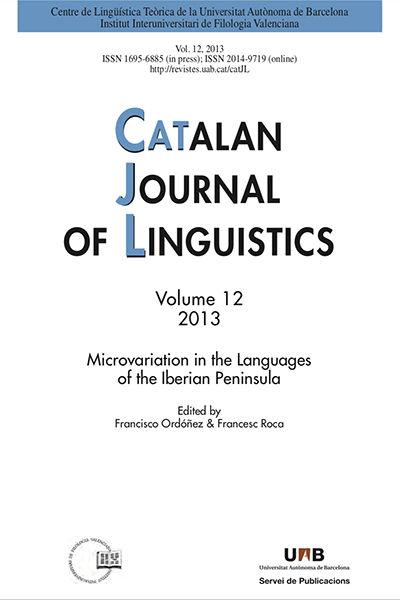
Autors:
Francisco Ordóñez & Francesc Roca (eds.)
Títol:
Microvariation in the Languages of the Iberian PeninsulaEditorial: Universitat Autònoma de Barcelona, Servei de Publicacions
Col·lecció: Catalan Journal of Linguistics #12Data de publicació: 2013
Pàgines: 305 Text completThis issue of the Catalan Journal of Linguistics was conceived with the idea to promote comparative studies of the languages spoken in the Iberian Peninsula. The importance of comparison in linguistics dates back to neogrammarians in the xix century due to their interest of discovering the common roots of most of the lan- guages spoken in Europe. In order to get to that objective, comparison of phonologi- cal patterns were crucial to retrieve the common Indo-European origins.
In the generative framework variation and comparison was not highlighted until the advent of Lectures on Government and Binding (Chomsky 1981), which marks the beginning of the Principles and Parameter theory. A parameter, in its original conception, is a principle with a dimension of variability with respect to a specific syntactic property (Head-initial or Head-final, Node for Subjaceny: S or S’). This variation can be expressed with the values + or –, and each value is associated to a series of syntactic correlations.
Títols de la col·lecció / Also in this series:
25 maig, 2014
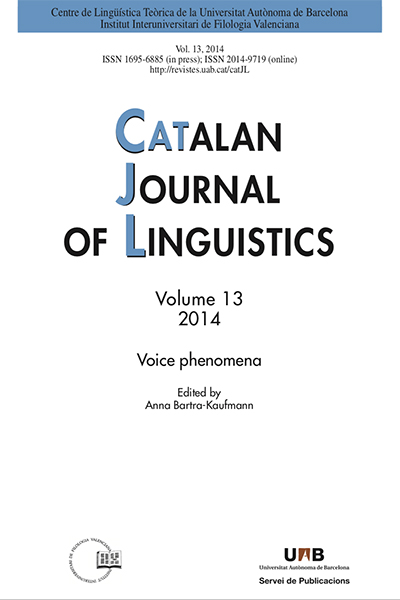
Autors:
Anna Bartra-Kaufmann (ed.)
Títol:
Voice phenomenaEditorial: Universitat Autònoma de Barcelona, Servei de Publicacions
Col·lecció: Catalan Journal of Linguistics #13Data de publicació: 2014
Pàgines: 122 Text completSpeakers’ intuitions, philosophical categories and traditional grammars have long considered some types of sentences, namely passives and middles, as the reversed or semantically synonymous mirror image of another construction type, name- ly active sentences. As soon as by Aristotle, pathos was proposed as a category that represented a way of approaching the relationship between participants in a situation or event. In the Romance tradition, grammarians tried to found equiva- lent forms for the Latin passive and middle paradigms, and considered the peri- phrastic be-Passive translations as functional and categorical equivalents. But the mismatches between meaning and formal properties, as well as the inadequacy of reproducing the categories of Latin grammar into Romance descriptions, were very soon apparent to grammarians.
The relevant question, one that can not be answered in the few lines of these introductory remarks, and which can be considered a sort of research program, is the following: is the speakers’ intuition of a semantic equivalence between active and passive sentences 4 a linguistic property to be accounted formally for or rather is it an interpretive epiphenomenon that loses its sense as soon as we decompose passive sentences in its formal components and properties? As the recent evolution of grammar shows and the papers inside this volume reflect, voice phenomena can be addressed from different perspectives, each one permitting to go a step further in our knowledge of the formal properties involved in them. The basic aim in this volume is to try to discover a little bit more about this intriguing property of lan- guages: the fact that different structures, made up with the same lexical elements but with different functional categories and formal features, express the same event.
Títols de la col·lecció / Also in this series:
25 maig, 2015
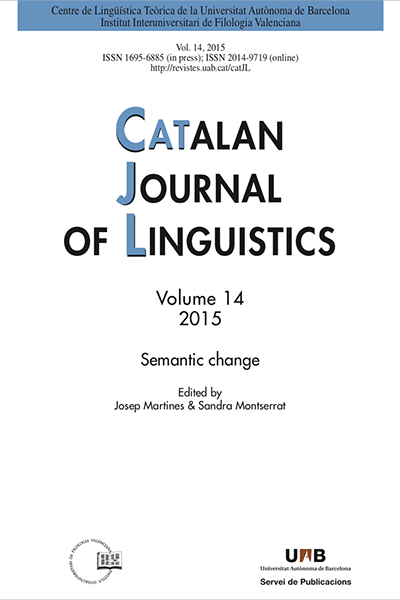
Autors:
Josep Martines & Sandra Montserrat (eds.)
Títol:
Semantic changeEditorial: Universitat Autònoma de Barcelona, Servei de Publicacions
Col·lecció: Catalan Journal of Linguistics #14Data de publicació: 2015
Pàgines: 237 Text completThe main topic of this issue of Catalan Journal of Linguistics, semantic change, is probably one of the areas of linguistic research gaining more prominence over the last years. This fact is possibly due to two circumstances. a) On the one hand, to the development of the meaning-oriented and usage-based approaches to lan- guage, which take place mainly (although not exclusively) within the theoretical framework of Cognitive Linguistics and Pragmatics. And, b) on the other, to the development of text corpora (representing both Old and Contemporary language in written or oral form), driven by the necessity to approach the communicative language usage.
The present issue of Catalan Journal of Linguistics gathers contributions on the main topics related to contemporary semantics: a) polysemy, polysemysation, synonymy, semantic and lexical lectal variation; b) metaphor and metonymy, subjectivation and intersubjectivation as mechanisms and factors of semantic change, respec- tively; c) pragmatic inference as a true trigger of semantic change; d) emergence, understanding, spreading and semantization of new meanings; e) grammaticalization, phraseologization and constructionalization as semantic changes; and, finally, f) inner (paradigmatic relations) and outer conditions (pragmatic, sociolinguistic and cultural factors) of semantic change. Grammaticalization, the Invited Inference Theory of Semantic Change (IITSC), Prototypicality Effects, pragmatic enrichment, the Theory of Conceptual Blending and image schemas constitute the theoreti- cal background of these ten papers, where concrete cases of semantic change in Catalan, Spanish, Italian and Portuguese are analysed.
Títols de la col·lecció / Also in this series:
6 febrer, 2016
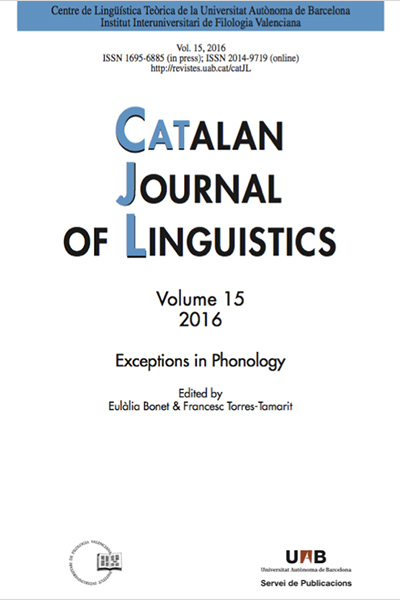
Autors:
Eulàlia Bonet & Francesc Torres-Tamarit (eds.)
Títol:
Exceptions in PhonologyEditorial: Universitat Autònoma de Barcelona, Servei de Publicacions
Col·lecció: Catalan Journal of Linguistics #15Data de publicació: 2016
Pàgines: 171 Text completThe origin of this volume is the Workshop on Exceptionality in Phonology, which was held at the Universitat Autònoma de Barcelona the 27 of January 2015 as part of the 12th Old World Conference in Phonology, and which featured Kie Zuraw (UCLA) as keynote speaker. From the seven talks that were presented at the Workshop, six appear in this volume, and one more paper that was not presented at the Workshop has also been included. The papers presented in this monographic volume are not meant to cover the totality of theoretical approaches and research activities on the topic at hand, which is certainly a very broad topic, but to present up-to-date work by leading phonologists on a topic that is a long-debated problem for phonological theory.
Títols de la col·lecció / Also in this series:


